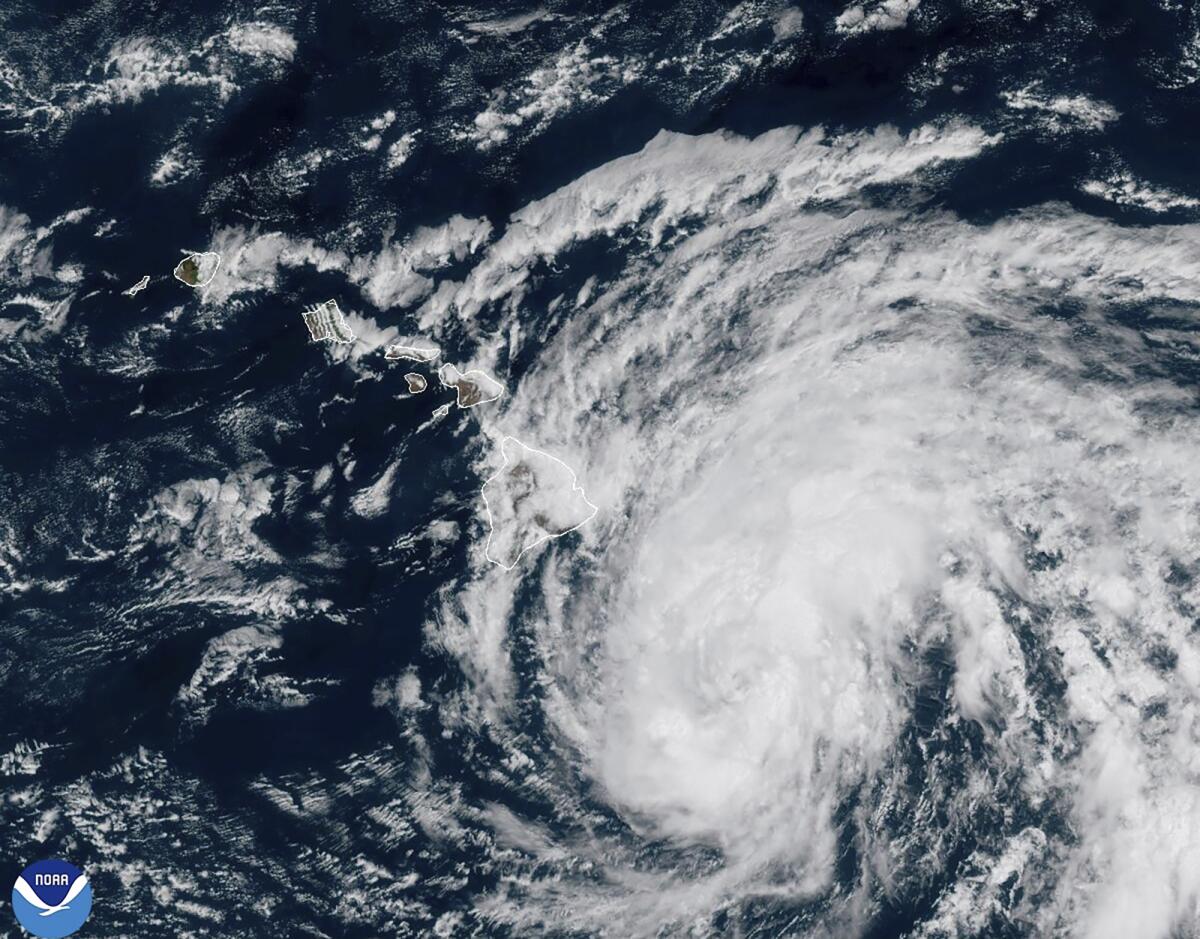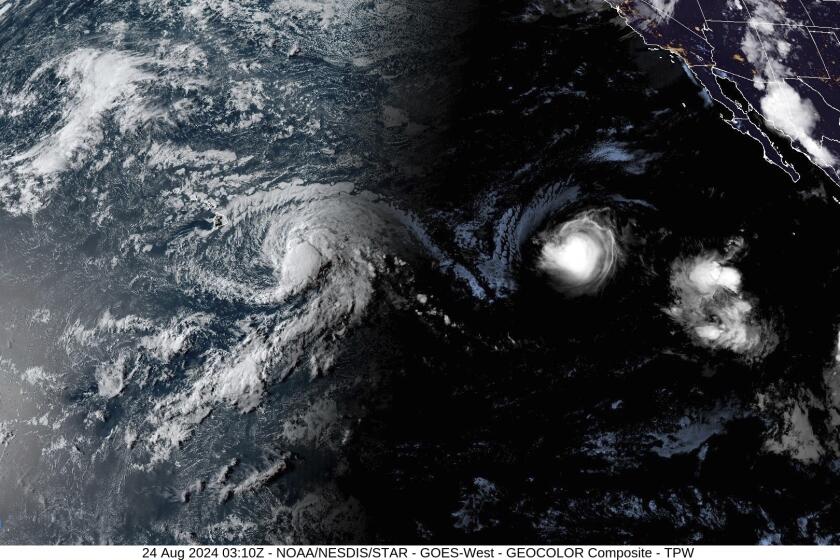Hurricane Hone sweeps past Hawaii, dumping enough rain to ease wildfire fears

- Share via
HONOLULU — Hurricane Hone passed just south of Hawaii on Sunday, dumping so much rain that the National Weather Service called off its red flag warnings that strong winds could lead to wildfires on the drier sides of the islands.
Meanwhile, the eastern Pacific saw a new threat emerge as Tropical Storm Hector formed, packing top sustained winds of 45 mph. There were no coastal watches or warnings in effect as Hector churned far out at sea, the National Hurricane Center said.
Hone (pronounced hoe-NEH) had top winds of 85 mph Sunday morning as it swirled slowly past the Big Island, centered about 45 miles off its southernmost point, according to Jon Jelsema, a senior forecaster at the Central Pacific Hurricane Center. He said tropical storm force winds were blowing across the island’s southeast-facing slopes, carrying up to a foot or more of rain.
Tropical Storm Hone is approaching Hawaii and will likely be a hurricane this weekend, adding danger of fires and floods.
Floods closed Highway 11 between Kona and Hilo, and a higher-altitude alternative, the Cane Road, was closed by flooding as well, isolating properties such as the Aikane Plantation Coffee Co. outside Pahala, where owner Phil Becker said his 10-inch rain gauge overflowed in the deluge.
“We’ve got quite a lot of flood damage. The gulches are running full speed ahead, and they’re overflowing the bridges, so we’re trapped down here. We can’t get in or out,” Becker said Sunday.
Becker said his plantation is off the grid, powered with batteries charged by solar electricity, and his family is safe, so they have no reason to evacuate. The weather may even prove beneficial: “We’ve been in a drought situation so the coffee is probably loving all this rain,” he said.
Hurricane Gilma, meanwhile, weakened to a still-major Category 3 hurricane Saturday night, but it was far east of Hawaii and forecast to weaken into a depression before it reaches the islands.
Shelters were opened as Hurricane Hone blew in and beach parks on the eastern side of the Big Island were closed due to dangerously high surf, Hawaii County Mayor Mitch Roth said.
Jelsema offered a vivid metaphor for the rainfall: “As the rain gets pushed up the mountain terrain, it wrings it out, kind of like wringing out a wet towel,” he said.
“It’s been really soaking those areas. There’s been flooding of roads. Roads have been cut off by high flood waters there in the windward sections of the Big Island, and really that’s the only portion of the state that’s had much flooding concern at this point,” he said.
Hone, whose name is Hawaiian for “sweet and soft,” poked at memories still fresh of last year’s deadly blazes on Maui, which were fueled by hurricane-force winds. Red flag alerts are issued when warm temperatures, very low humidity and stronger winds combine to raise fire dangers. Most of the archipelago is already abnormally dry or in drought, according to the U.S. Drought Monitor.
The Aug. 8, 2023, blaze that torched the historic town of Lahaina was the deadliest U.S. wildfire in more than a century, with 102 dead. Dry, overgrown grasses and drought helped spread the fire.
Calvin Endo, a Waianae Coast neighborhood board member who lives in Makaha, a leeward Oahu neighborhood prone to wildfires, has worried for years about dry brush on private property behind his home. He’s taken matters into his own hands by clearing the brush himself, but he’s concerned about nearby homes abutting overgrown vegetation.
“All you need is fire and wind and we’ll have another Lahaina,” Endo said as the storm approached. “I notice the wind started to kick up already.”
The cause of the Lahaina blaze is still under investigation, but it’s possible it was ignited by bare electrical wire and leaning power poles toppled by the strong winds. The state’s two power companies, Hawaiian Electric and the Kauai Island Utility Cooperative, were prepared to shut off power if necessary to reduce the chance that live, damaged power lines could start fires, but they later said the safety measures would not be necessary as Hone blew past the islands.
Roth said a small blaze that started Friday night in Waikoloa, on the dry side of the Big Island, was brought under control without injuries or damage.
Sinco Kelleher and Walker write for the Associated Press. Walker reported from New York.
More to Read
Sign up for Essential California
The most important California stories and recommendations in your inbox every morning.
You may occasionally receive promotional content from the Los Angeles Times.









